Kimberley, South Africa
Kimberley - Newsletter #25


Kimberley Ex-Pats Newsletter no 25, December 2019
Compiled by Geraldine Auerbach MBE London
Business and Professional Activity in Kimberley
Dave Apter has shared a link on the Kimberley history Face Book group ‘Kimberley Calls and Recalls’, to the Business Table that Leon Chonin so excellently compiled for our website. This posting, on 9 December, produced a flurry of warm responses from some of their over 5000 members, some people remembering working for some of the firms and/ or dealing with them, especially with the wholesalers. They said:
-
•What a tremendous legacy - so many wonderful families who were the heart of Kimberley! Dr Hammar delivered me and my siblings - my mom just adored Isadore Hammar!! Thank you, Dave.
-
•Thanks. So many memories of friends and others on the list. (My late parents used to visit and party with them).
-
•My late dad dealt a lot with A David, Awerbuck & Brown, Klein Bros, S Apter and other wholesalers.
-
•My late Dad also dealt with all the mentioned wholesalers plus E. Benjamin w’salers.
-
•My late ouma would always say: "Ons moet goed wees vir die Jode. Hulle is die uitverkorende volk van die Here, en as die Jode besigheid doen in jou dorp, is dinge gewoonlik voorspoedig." She was a very wise old woman.
-
•And someone asked: What about the late Aubrey Sacks a quantity surveyor who was partners with Dave Allen?
You can refresh your memory of the people on the table, which is on our website here https://kehilalinks.jewishgen.org/Kimberley/bus.html and you can see the Face Book group comments here. https://www.facebook.com/groups/1374275302814914/
Wholesale Firms in Kimberley

I have begun developing the stories of the wholesale firms and of the families who started and maintained them. I have identified the following as the 10 best-known firms in Kimberley in alphabetical order. (If you know others that should be on this list, please let me know)
-
1S APTER & Co (Pty) Ltd General Wholesalers
-
2AWERBUCK, BROWN & Co (Pty) Ltd General Wholesalers
-
3BENJAMIN BROS Wholesale Softgoods
-
4E BENJAMIN & Co Wholesale Softgoods
-
5A DAVID & Co General Wholesalers
-
6L ISAACSON & Co Wholesale Softgoods
-
7KLEIN BROS General Wholesalers
-
8R. SENDEROVITZ & Co Wholesale Groceries
-
9SUSSMAN BROS Premier Meat Supply
-
10WHITEMAN & Co General wholesalers
S Apter & Co (Pty) Ltd
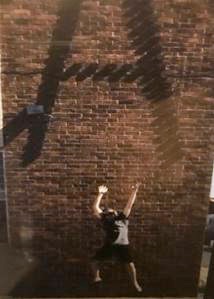
I was delighted to receive from Robin Apter (now in Australia) an extensive story about Solomon Apter and all his children – and grandchildren and about the firm he founded, S. Apter & Co.
Lois Apter (Dave Apter’s wife) then sent this evocative picture of Mendel’s grandson Tim Apter, reaching for the ever-present ‘A’ in the brickwork on the firm’s building in Southey Street.
You can now read the Apter family story and see the pictures on the website under ‘Families / Apter here: https://kehilalinks.jewishgen.org/kimberley/Apter.html
Awerbuck Brown & Co (Pty) Ltd
I think I have already shown you the extraordinary story from the DFA about Harry Brown and Raphael Awerbuck, who originally went into partnership in 1907, trading in wet fish. (This was the start of SA Fisheries which then continued with Sam Jawno and Laz Barnett). Then in 1932 they set up their wholesale business in Transvaal Road. This story is also now on the website under both ‘Brown. Harry and Family’ and ‘Awerbuck, Raphael and family’.
E Benjamin & Co
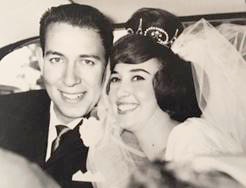
Bernard Benjamin (pictured with his wife Hellen) has also written his family story and a lovely account of the development of E Benjamin & Co. You can also see his story and pictures on the family pages, under Benjamin, Bernard.
A David & Co
I have sourced some interesting material on the David family from the internet and from my own memories as well as from from seeing (on our website) the tombstones in the Kimberley cemetery. There is now a story about Louis David, his brother Bennie David and their father Abraham David, who started A David & Co. This posting includes a bit about Louis’ wife Connie David’s brother Benjamin Bennett. He was born in Kimberley and educated at Kimberley Boys High School. He went on to become a journalist and crime correspondent on the Cape Argus and a prolific crime writer. We can also see some of the pioneering classic villas that Louis’ son, the architect Aubrey David, designed and built on the Costa del Sol. https://kehilalinks.jewishgen.org/kimberley/David_Family.html
Senderovitz
Gwynne Robins (née Schrire) has written about her great grandfather Raphael Senderovitz, a friend of Sir Ernest Oppenheimer. He was certainly one of the pioneer wholesale traders and mill owners in Kimberley and Beaconsfield in the early 1900s.
Sussman Bros, Premier Meat Supply
Cecil sent me, before his sad passing earlier this year (2019) the story of the Sussman brothers, Philip, Guttel, Kollen and George and how Premier Meat Supply developed.
I am pleased to say that Eli Rabinowitz as done wonders these past weeks, and you can now see all these wholesaler stories on the family pages of the website. https://kehilalinks.jewishgen.org/kimberley/Families.html
I am planning to write a dedicated article about the wholesale scene in Kimberley. I am wondering if the families of the other wholesalers on the list will send me their stories and pictures to go with this. I am sure the Klein children and grandchildren can fill in some valuable and interesting news about their family and their business, Klein Brothers. Who can tell us something about Isaacsons and Whiteman & Co. Perhaps the Haberfeld and Hendler children who still remain, will do so? Please also send pictures of the buildings and the family members involved.
The Smous (plural Smouse)
When writing an introduction to my Wholesalers’ article (which is still ongoing) I realised how wholesale trading was a natural development of the Jewish peddler or smous, who started off on foot selling one item (eggs, rags, fruit) in the streets of the town, and then graduated to a donkey cart and ranged far and wide.
It worked like this. An immigrant that had graduated from door-to-door peddling, and now own a little shop, would welcome a landsman and give him a start by supplying him with goods at extended credit. There was discussion amongst those already establishing themselves as to what commodities, and in what areas, the newcomer should peddle, so as not to compete. Once he got on his feet, the newcomer was able to buy a cart and some donkeys and become a traveller for the person who set him up (or for himself) setting off into new areas to bring the necessities of life to farmers and small shopkeepers throughout the countryside.
He carried everything a household would need, sacks of grain; tinned meat and fish; tea coffee and sugar; blankets; tablecloths; pots and pans; brooms and buckets, firewood, cloth, clothing and sewing materials; jewellery and even eyeglasses. The farmers sometimes bartered with him in livestock, skins, wool or mielies which he then brought to the towns and sold to others.
Offering to take payment in instalments, the Jewish peddler had reason to visit his customers on a regular basis and got to know them well. Often the farmers would give him hospitality over-night. The Afrikaners, revering the Jew as the People of the Book, might invite him to read the Bible with them.
Every smous longed to own his own store. Many of these itinerant traders were able set up shop in the small towns all over the country. (My own grandfather, Tobias Kretzmer, started by selling eggs door to door in 1899 , then became a glazier and was eventually in about 1903, was able to set up a general dealers’ store in Malmesbury, near Cape Town.
You can read a book review of Jewish peddling round the world between 1880 and 1920, showing how it all was part of a tight-knit Jewish economic system.
https://www.nyu.edu/about/news-publications/news/2015/january/hasia-diner-on-jewish-peddlers.html
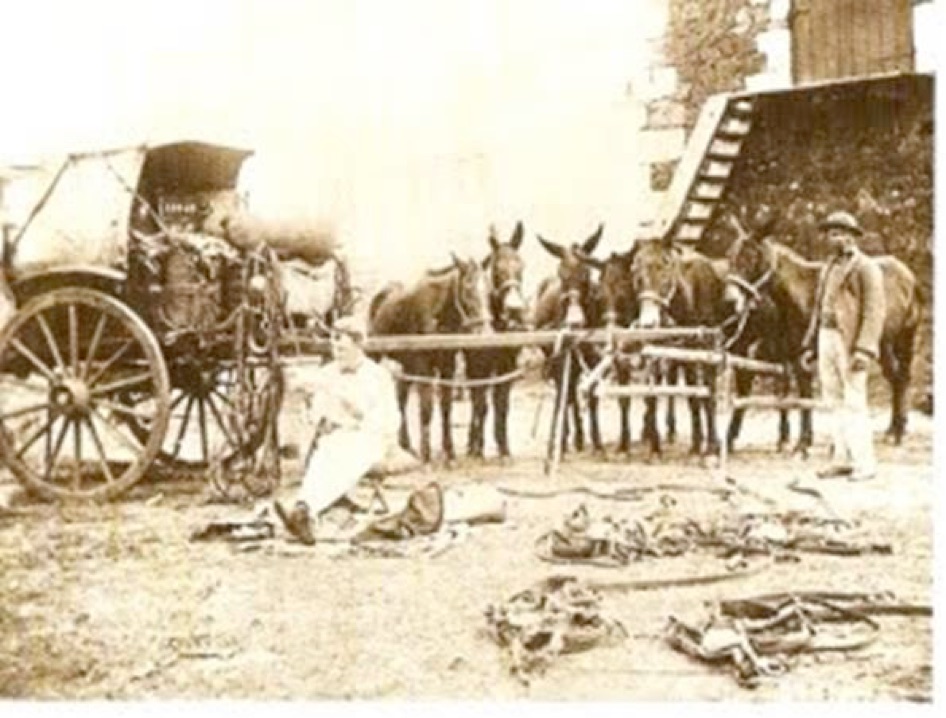
Above, we see a typical peddler outfit. A small cart packed to the rafters, six donkeys outspanned by the coloured servant and the smous sitting on his bags of mielies.
It was a lonely life. He made sure he was home for Shabbes. He loaded up on Sundays and was out on the dusty roads with just his servants, usually a white driver and packer, and a coloured youth who looked after the livestock and the donkeys. It was also dangerous. He had money on him, usually chained to his belt or the wagon. He was sometimes attacked and robbed. The unfortunate smous from Kimberley, Philip Borkum was actually strangled, in 1906, by his servants who escaped with his money and some items of clothing. They were later apprehended, tried and executed for the murder.
The word ‘smous’
I had thought the word ‘smous’ was a descriptive term, sometimes even used as a badge on honour. However, Leon Chonin told me that his parents said one should avoid using that word. They said that Jews felt that being called a smous was insulting. That led me do a bit of research.
I found the situation to be complex. In the City of Graaf-Reinet, they have put up a memorial plaque on the main street honouring, the ‘Jewish Pedlars’ / ‘Joodse smouse’ in English and Afrikaans, (with some Hebrew letters and a star of David). (see picture below). The plaque reads: ‘In honour of the pioneer Jewish Pedlars (alternative spelling for peddlers) known as smouse who traded in outlying and remote country districts. They supplied their customers with many of the necessities of life. In the course of their trading, they made a contribution to the economic development of the country’.
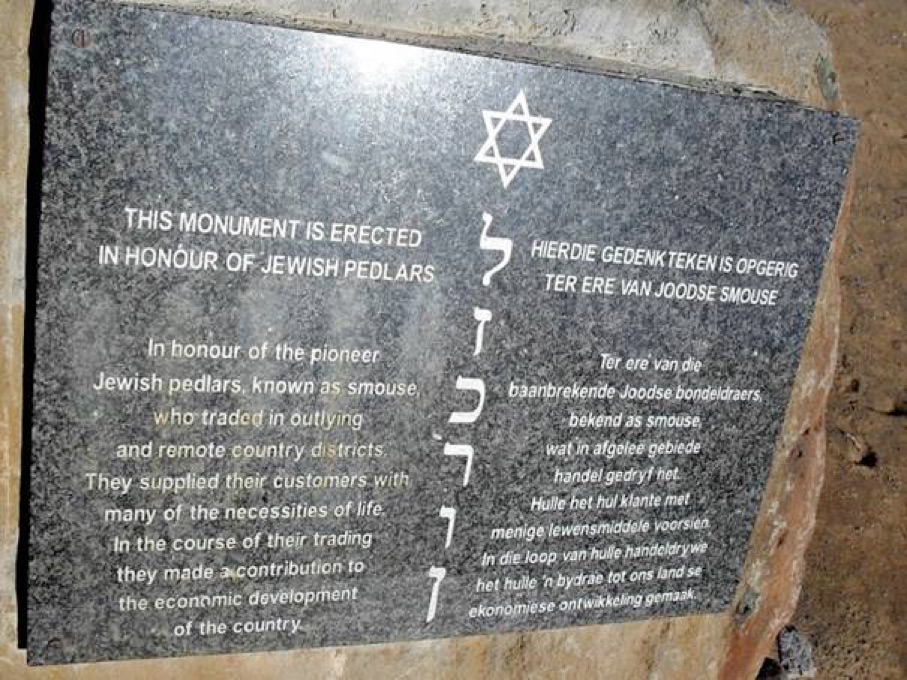
A display in the South African Jewish Museum in Cape Town, uses the word ‘smous’ in telling the story of those who chose to fan out across the country into the small rural communities. They say: ‘Known as smouse (peddlers) they travelled in wagons with goods for sale and many settled and opened shops in these tiny towns and villages that once had thriving Jewish communities (although this is no longer the case).’ They continue, ‘The footsore smous, the itinerant trader who trudged and trundled between farmsteads selling all manner of articles to farmers and their families, has become a figure of legend within South African Jewish memory.’
I also posted the question on the South Africa Jewish Genealogy forum about their understanding of this term. The first response from Adrian Friedman said it was a derogatory term. Next Jeremy Lichtman of Toronto wrote: I don't know if the word is pejorative or not, but the traveling Jewish peddler was usually seen in a positive light, as they were the ones bringing news (gossip?) and urgently needed supplies to remote farming areas that seldom saw other outside traffic.
And, Dean van der Westhuizen explained: ‘I am Afrikaans speaking and as we all know Afrikaans is made up mainly of Dutch but also a mixture of other languages. We know the term Smous to be a Peddler. Growing up in South Africa we never ever thought anything derogatory about the term and as a young boy I still recall people going from door to door selling goods such as cutlery, encyclopaedias and even plastic Tupperware. We even use it as a compliment for some Sales Agents to say they can smous anything. The Jewish Community in South Africa was instrumental to the building of the Economy in South Africa, they started a lot of the main trading routes. I take my hat off to those Jewish men who walked 1000’s of kilometres over rough terrain here in SA with our extreme temperatures. I personally am proud of the Smouse because they helped the Afrikaaner Nation.
Even the derivation of the word seems unclear. Bubbles Segall from Melbourne Australia. ex Stellenbosch. says: ‘I was told that the word “Smous” has a Dutch derivation that means ‘soos Moses’ - in other words Jews had Moses in their bible. Leon says it’s similar to German and Yiddish words like Shmow and Shmok which are terms of derision. Others say the Yiddish derivation is from shmooze – to sweet talk.
I suppose any word can be used in a derogatory sense. Even, and perhaps often, the very word ‘Jew’ or ‘Yid’ is used in a pejorative way. There are certainly instances, in local literary sources, of the words ‘smous’ and ‘Jew peddler’ being used in a disparaging and negative way. And no doubt there were scoundrels who charged too much and ‘verneuked’ the Boers, earning such a reputation.
I leave the last word to historian Milton Shain who said ‘The collective South African Jewish memory has romanticized the smous in his wanderings, but he was also not always welcome, and often a figure of derision.’ So, we should use this word cautiously.
Other Family News
Well it’s not exactly ‘news’ as we are looking back several generations – but we are glad to say that as well as the Wholesale families, many new family stories are now on the website.
You can also read the Ginsberg family provided by Herschel Ginsburg and Jean Tockar (née Ginsberg); the Moross Family. There is also a much-extended version of Gwynne Robins (née Schrire family story) with links also from Schrire Sam and Schrire Louis and Schrire, Velva and Raphael Senderovitz.
You may like to see the Diamond family – Sonia, Ray, Saul (Solly), Barney, Aaron (Beady) and Ivan. Daughter of Sonia, Shirley Talerman (née Silkiner) of London, has pieced this together for us how Solly supplied horses for the troops and for the visit of the Royal Family, and how Beady and Ivan dealt in saddlery.
Pilots, Bombers and Gunners
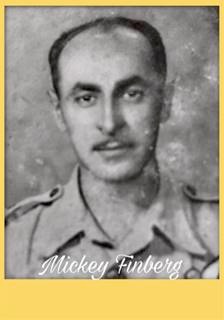
What struck me in reading the new family stories that are now on the website, was how many of our small Kimberley Jewish Community served successfully in the South African Air Force (SAAF) in World War Two. Eleanor Kotkis writes in her story that her father, Mickey Finberg, served as a gunner, officer, lieutenant and observer. His plane was the only survivor of two major battles called Boston Tea Party and Marauder Massacre. He was in 24 Squadron from 1940 to 1944.
Who of us, I wonder, knew that Alec Apter was in the Air Force mainly as a bomber pilot but with a stint on the Spitfires as well?

Vanessa Rubin wrote about her father Buddy Goldman, ‘One could say our father was “game” for everything. He had a mischievous streak. Buddy certainly was a brave pilot during the 2nd World War. He was captain of his squad. He flew troops and ammunition endlessly with great bravado, his cap on the back of his head, up and down Africa, furious that he wasn't at the front. Nevertheless, he had some traumatic experiences during the war, being shot down by enemy fire on the Gold Coast at the tender age of 22 and suffering a bad bout of Malaria as well as poisonous spider bites living in a tent in those tropical climates. (He always managed to bring some Chanel No 5 back for his little sister, Joy.)’
Buddy’s older brother Vernon Goldman also saw service in World War II, firstly with the Kimberley Regiment, and later with 24 Squadron SAAF, reaching the rank of Captain. He had been mentioned in despatches. After the war in 1946, he sadly died aged 28 in a plane crash at Kimberley airport, piloting a Piper J Cub – killing also his friend and passenger, Joseph Noggid. This left both Kimberley families devastated! (You can read the stories of all these under Goldman, Buddy and Noggid, Harry on the family pages).
It would be interesting to do an article on war service by the Kimberley Jewish Community so if you would like to send me information of how your family members may have served in the army in WW2, we can see what we can do.
Rabbi Oscar Werner
We have now posted the new tribute, sent us by his son Bernard (now called Dov) Werner, to our revered Rabbi Oscar Werner who lead our community with his wife Leah and three children Sharon, Bernard and Malka from 1957 to 1970. (This is on Rabbi Werner’s family page together with the tribute by Leon Chonin, already posted.)
I was delighted to hear from Rabbi Werner’s daughter Malka (now called Maxine Lubkin). She writes: ‘My brother Dov has been forwarding to me some of the Kimberley expat newsletters you edit so well. I am, by the way, Maxine Lubkin, aka Malka Werner. I live in Rochester, New York, USA.
‘Many thanks to you and Leon Chonin for the tribute to my late father. It was really interesting to see the picture of my parents and some of the Kimberly youth. I was amazed that all the names, as well as faces, are familiar to me! I actually vaguely remember that picture being taken. Or, perhaps we had that picture somewhere at home! If memory serves, it was taken one Sunday after morning Hebrew class (Cheder). Those in the picture are, by the way, only a small fraction of the number of young people in the community at that time.
Dov, who, for your information, is a doctor living in Efrat, Israel, has been nagging (encouraging?) me to contribute to the newsletter. I've not been very motivated to do that, but I just felt I needed to reach out to you, personally, about the tribute - a long overdue acknowledgment of my dad's immense contribution to that community!’
Well Malka/Maxine – you have now contributed successfully to the Newsletter. We will send you your own copy in future, and we look forward to hearing from you, any other reminiscences of Kimberley and the children you knew when you were growing up in the community.
Feedback
We love feedback – you know I send out these Newsletters winging their way across the firmament to a few hundred people. We really appreciate if we get a response – to know you have received it and see any comments you would like to make.
We have posted feedback to Newsletter no 24 at the end of the Newsletter on the website. You can see comments on High Holydays in Kimberley from Daphne Toube, June Haberfeld, Theo Klewansky, Jonathan Joseph, David Friedman, Gwynne Robins and Barney Horwitz here: Newsletter #24 September 2019
Book Recommendation
I’m not sure if we posted this before? Milton Jawno says: I would like to strongly suggest that all our ex-Kimberlites who are interested to research the origins of our pioneering families should read the book Shtetl: The history of a small town and an extinguished world by Eva Hoffman. This masterful work deals with the history of the Jews of Poland, Lithuania, Estonia and Latvia over the past thousand years and provides a direct link and understanding of the Jews of Kimberley, their origins and history prior to coming to South Africa. Leon Chonin has read it too and would also highly recommend it.
In Conclusion
If anyone would like to be in touch with anyone else, please write to me and I will see if I can put you in touch.
Have a happy Chanukah everybody.
Geraldine
Newsletter no 25
Compiled by Geraldine Auerbach MBE, London, December 2019


